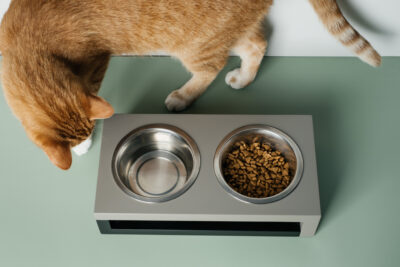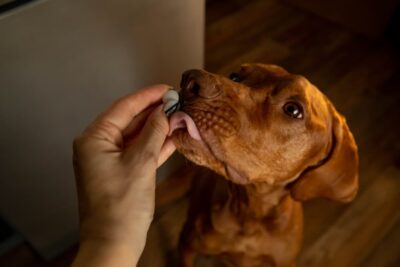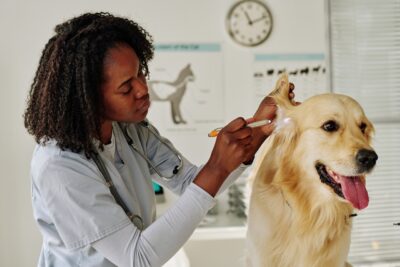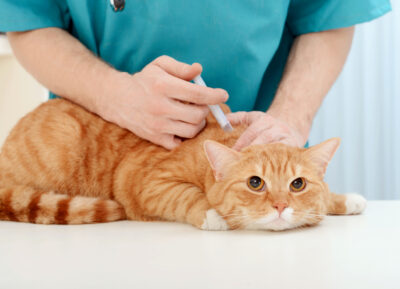Theophylline for Dogs

Medication details
- Medication type: Bronchodilator
- Form: Liquid, Capsule, Tablet
- Prescription required? Yes
- FDA approved? No
- Brand names: Theo-24, Theolair, Choledyl, Slo-Bid, Theo-Dur, Theo ER
- Common names: Theophylline
- Available dosages: Many. Talk to your veterinarian about dosing.
- Expiration range: Capsules typically have a long shelf life (years), liquids may expire more quickly.
If your dog has been diagnosed with bronchitis, asthma, or other breathing difficulties, your veterinarian may prescribe a bronchodilator such as theophylline. Theophylline reduces inflammation and airway spasm, allowing your dog to breathe more easily.
This medication is a staple of bronchitis and asthma management in both human and veterinary patients, and it is often used in conjunction with other treatments.
Theophylline is well tolerated by many dogs, but there are some things you should know before starting this medication for your pet.
What is Theophylline?
Theophylline is a bronchodilator medication that is used to relax smooth muscles in the airway and reduce inflammation. This medication can also increase the patient’s heart rate and make the heart contract more strongly. Theophylline is commonly used in humans. It is not FDA-approved for use in animals in the United States, but may be used off-label under the guidance of a veterinarian. It is approved for use in cats and dogs in the United Kingdom.
Theophylline is available by prescription only, either through a human pharmacy or purchased directly from your veterinarian. There are many brands of theophylline available on the market, but some do not work as well in dogs as they do in humans.
Your veterinarian will likely recommend a specific brand of the drug, or he or she may special order the medication through a compounding pharmacy.
What Is Theophylline Used For in Dogs?

Theophylline is primarily used to treat bronchitis, asthma, collapsing trachea, and other breathing difficulties in dogs. It is also used for some conditions that cause abnormal heart rhythms in dogs, such as sick sinus syndrome.
Theophylline causes the smooth muscles in the lungs to relax, allowing airways to dilate. This improves airflow and allows mucus to be cleared from the airways more easily. Theophylline also has anti-inflammatory properties, which relieves airway spasms and reduces swelling.
Theophylline Side Effects in Dogs
Side effects primarily occur when theophylline is used at higher doses. The effects of this medication on dogs can vary widely depending on the brand of medication and the individual dog’s response to it, so it is very important to monitor your dog closely for side effects.
Common side effects of theophylline use in dogs include:
- Vomiting
- Diarrhea
- Restlessness
- Excitement
- Twitching
- Convulsions
- Increased drinking and urination
- Increased heart rate
- Loss of appetite
- Sedation
If your dog experiences any of these side effects, stop giving the medication and contact your veterinarian right away.
For dogs taking theophylline long term, your veterinarian may recommend annual or biannual blood work to monitor your dog’s theophylline levels. This can prevent overdoses and ensure your dog is receiving the maximum benefit from the medication.
Reactions With Other Drugs and Medications
Theophylline interacts with several medications and supplements. Some medications can increase your dog’s metabolism of theophylline, which can make theophylline less effective. Other medications may decrease metabolism, putting your dog at risk of a theophylline overdose.
Before starting theophylline, make sure you tell your veterinarian about any prescription, over the counter, or supplement medications your pet takes.
Medications known to interact with theophylline include:
- Erythromycin
- Propranolol
- Methotrexate
- Cimetidine
- Phenobarbital
- Rifampin
- Lithium
- Phenytoin
- Cardiac glycosides
- Fluoroquinolone antibiotics
If your dog is taking any of these medications, be sure to discuss the risks of theophylline with your veterinarian. Your dog’s theophylline dosage may need to be adjusted in order to limit the interaction with other medications.
Theophylline Dosage for Dogs

Theophylline is an especially tricky drug to dose appropriately. Different brands of theophylline may have varying efficacy in dogs. Individual dogs may also react differently to the drug, so it may take some trial and error to find the best product and the correct dose for your dog.
Your veterinarian may recommend blood work to monitor your dog’s theophylline levels, which can help determine the best dose. You will also need to monitor your dog closely for any side effects and let your veterinarian know if your dog is responding well to the treatment, as these factors can also guide dosing.
Always follow your veterinarian’s dosing instructions carefully, and do not change the dose or discontinue the medication unless directed to do so by your veterinarian.
Price of Theophylline for Dogs
The price of theophylline can vary depending on the brand, dose, and formula. Extended release or compounded medication may be more expensive, but often provide better results. If a human formulation of theophylline is used, coupons may be able to offset some of the cost.
Theophylline Storage Instructions
Theophylline should always be stored in a cool, dry place, away from direct sunlight. Most theophylline preparations should be stored at room temperature (60-77 degrees), but always check the packaging and follow the manufacturer’s instructions for safe storage and handling.
Theophylline Alternatives for Dogs

Diseases like bronchitis and asthma are complex and are often managed with a combination of medications and lifestyle changes.
If your dog is unable to tolerate theophylline, your veterinarian may recommend another bronchodilator medication such as terbutaline. Sometimes, both of these medications are used together. Your veterinarian may also recommend other medications such as steroids to reduce airway inflammation and an inhaler to further relax the airways. The exact combination of drugs will depend on the severity of your dog’s condition and it may take some trial and error to find what works best for your dog’s individual needs.
Environmental management can go a long way to reducing bronchitis and asthma symptoms. Reducing dust and pollen, using HEPA air filters, and avoiding products with fragrances can help manage these conditions.
With a combination of medication and environmental changes, your dog will soon be breathing easier!









